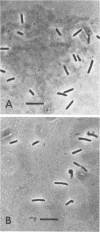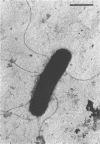Abstract
Studies on the physiological characteristics of two obligately anaerobic, rod-shaped bacteria from the human intestinal tract indicated that the organisms represented two previously undescribed species of Bacteroides, for which we propose the names Bacteroides pectinophilus (type strain, N3) and Bacteroides galacturonicus (type strain, N6). Both strains were pectinophilic; that is, they utilized as fermentable substrates for growth only pectin and a few related compounds. The two species differed significantly from each other in guanine plus cytosine content of the DNA, in substrate utilization patterns, and in other phenotypic characteristics. Both species deesterified pectin by means of an extracellular pectinesterase (EC 3.1.1.11) activity. Polygalacturonate (the main component of deesterified pectin) was depolymerized extracellularly with formation of unsaturated products by both species. The depolymerizing activity required Ca2+, functioned at a higher rate when polygalacturonate was the substrate as compared with pectin, and had an alkaline pH optimum. These data, as well as viscosity decrease studies and identification of products formed from polygalacturonate, indicated that the extracellular depolymerizing activity of either species was characteristic of an exopectate (exopolygalacturonate) lyase. The exopectate lyase activity had an unusual action pattern that resulted in terminal cleavage of unsaturated trigalacturonic acid units from polygalacturonate. An unsaturated trimer was the major product that accumulated in cell-free reaction mixtures, where it was not cleaved further. Growing cells of both Bacteroides species released the exopectate lyase into the external environment by processes that did not involve cell lysis to any significant extent.(ABSTRACT TRUNCATED AT 250 WORDS)
Full text
PDF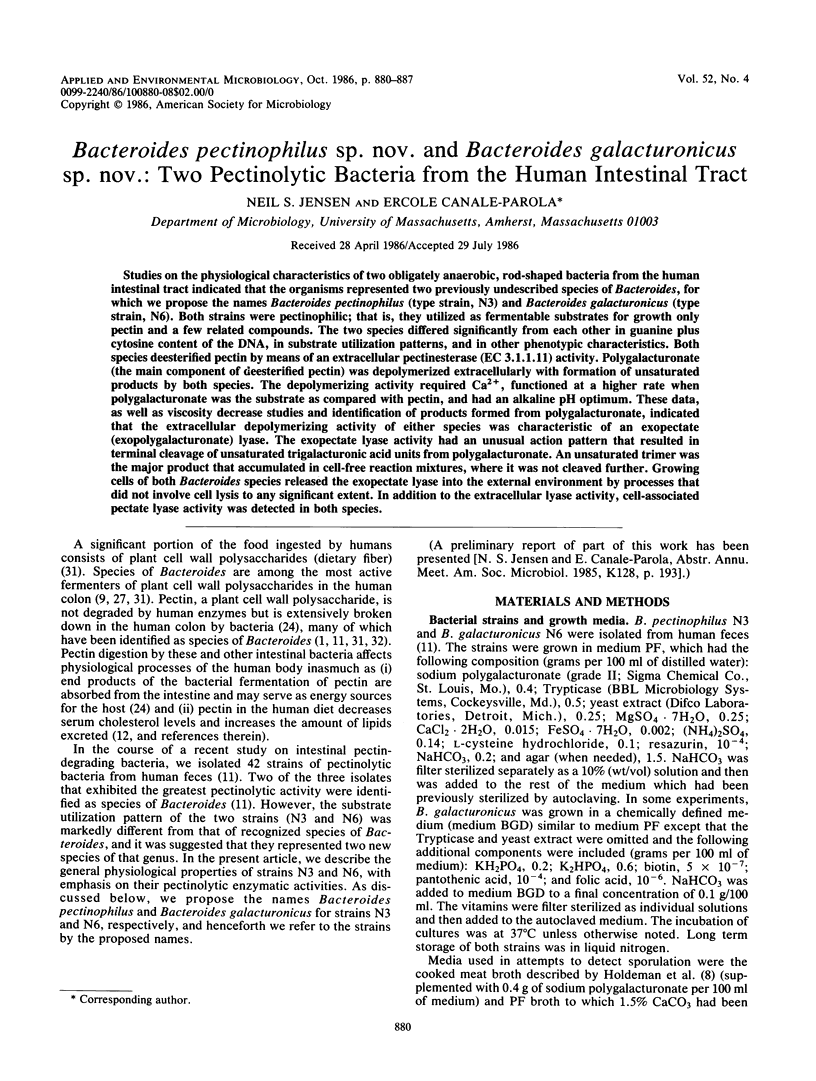
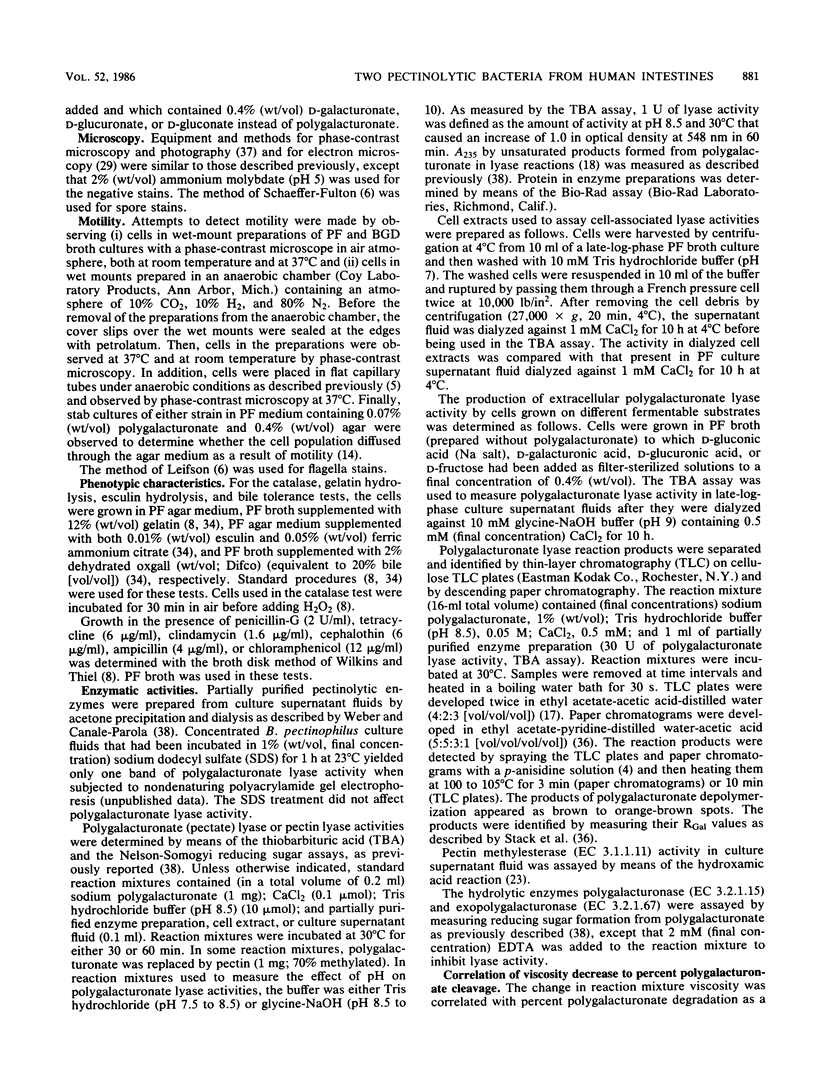
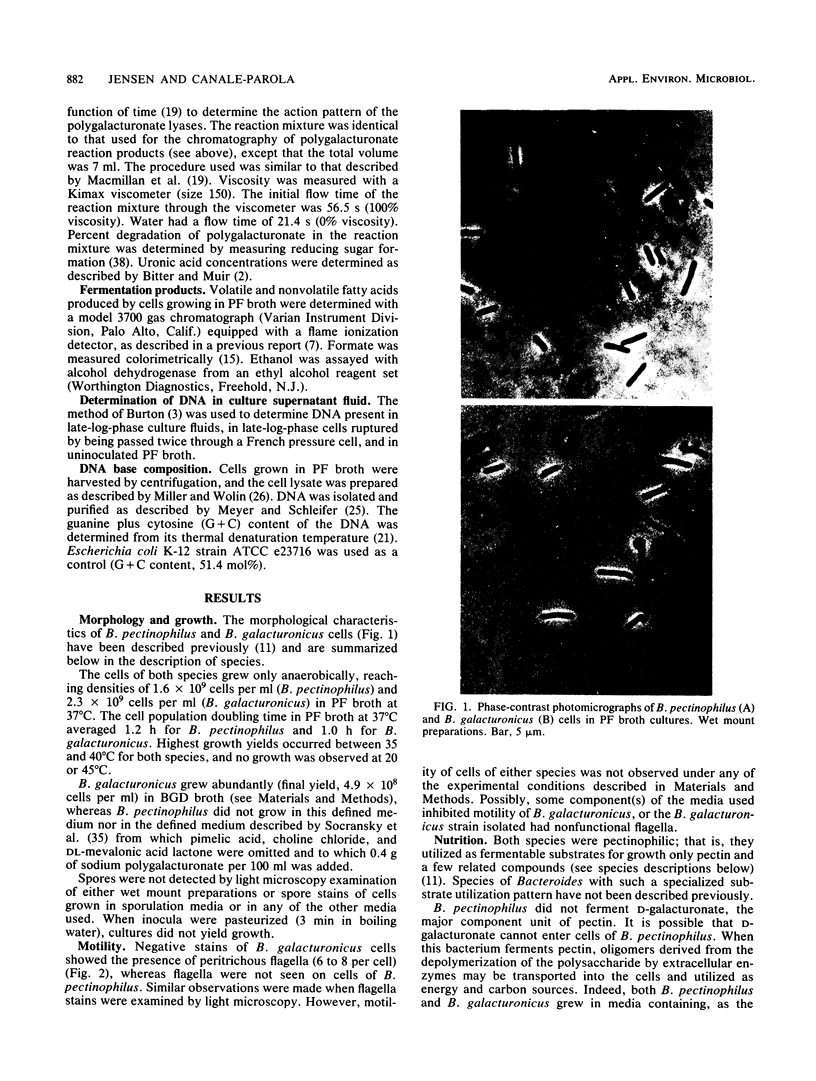
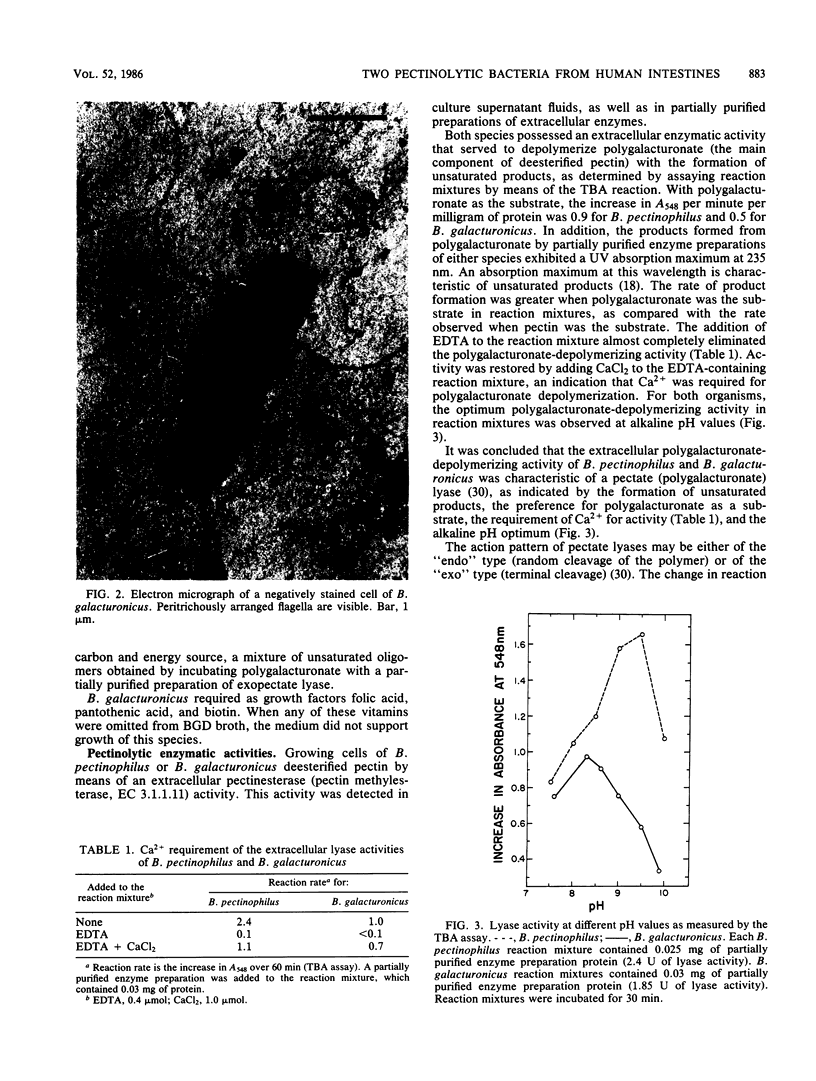
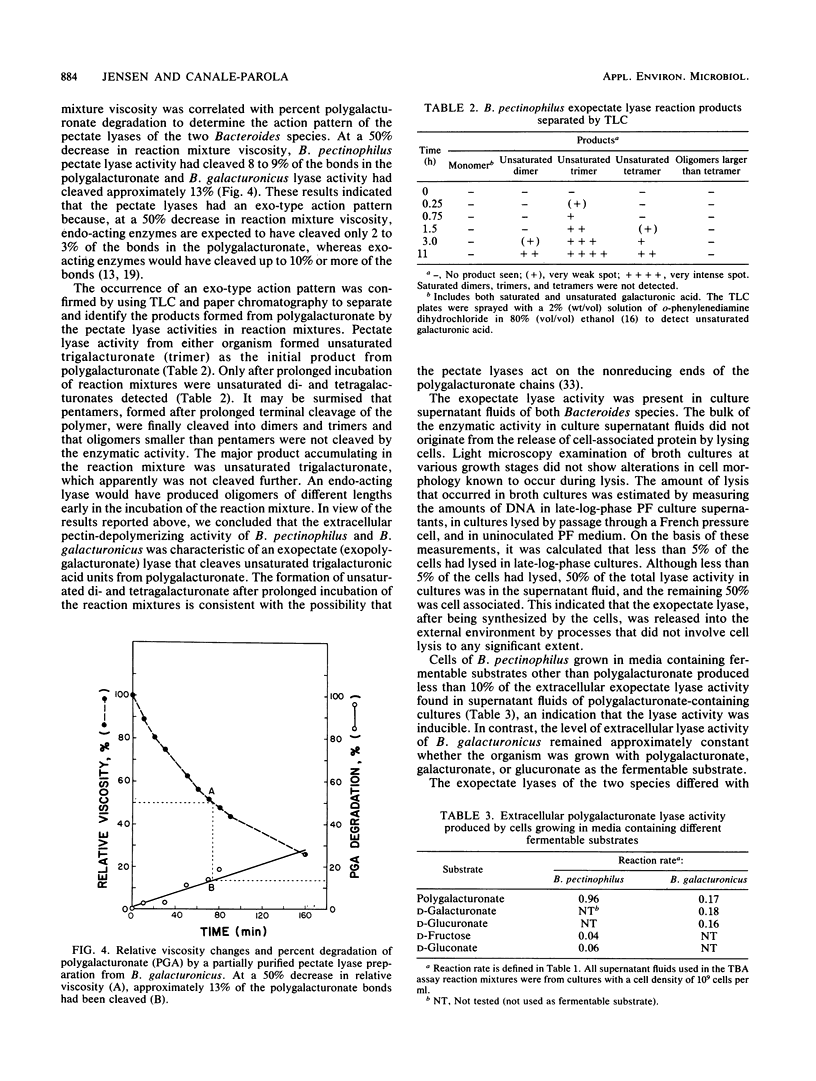
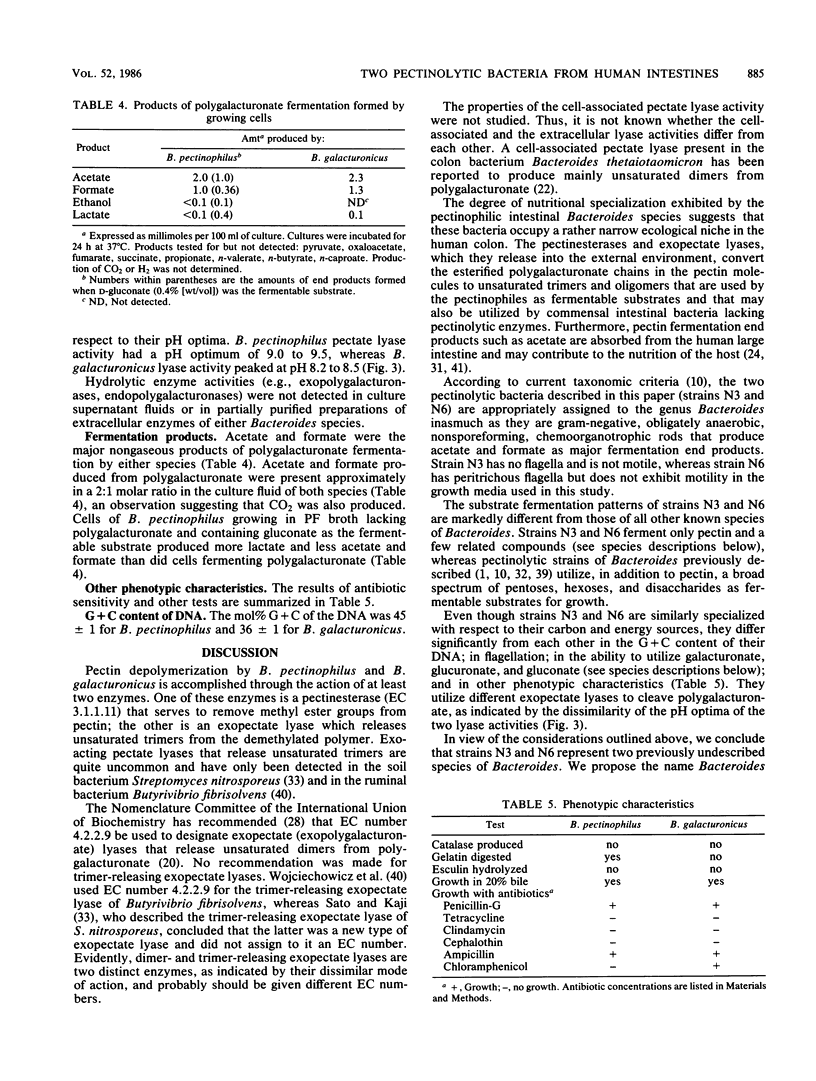
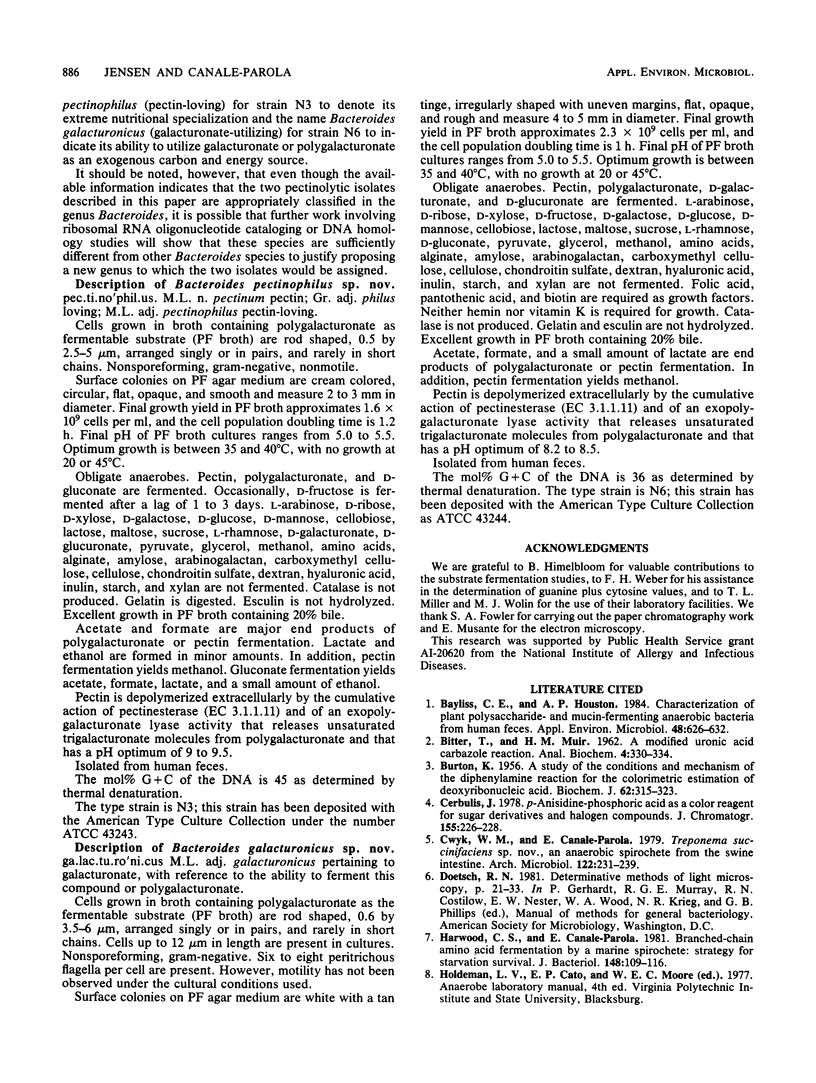
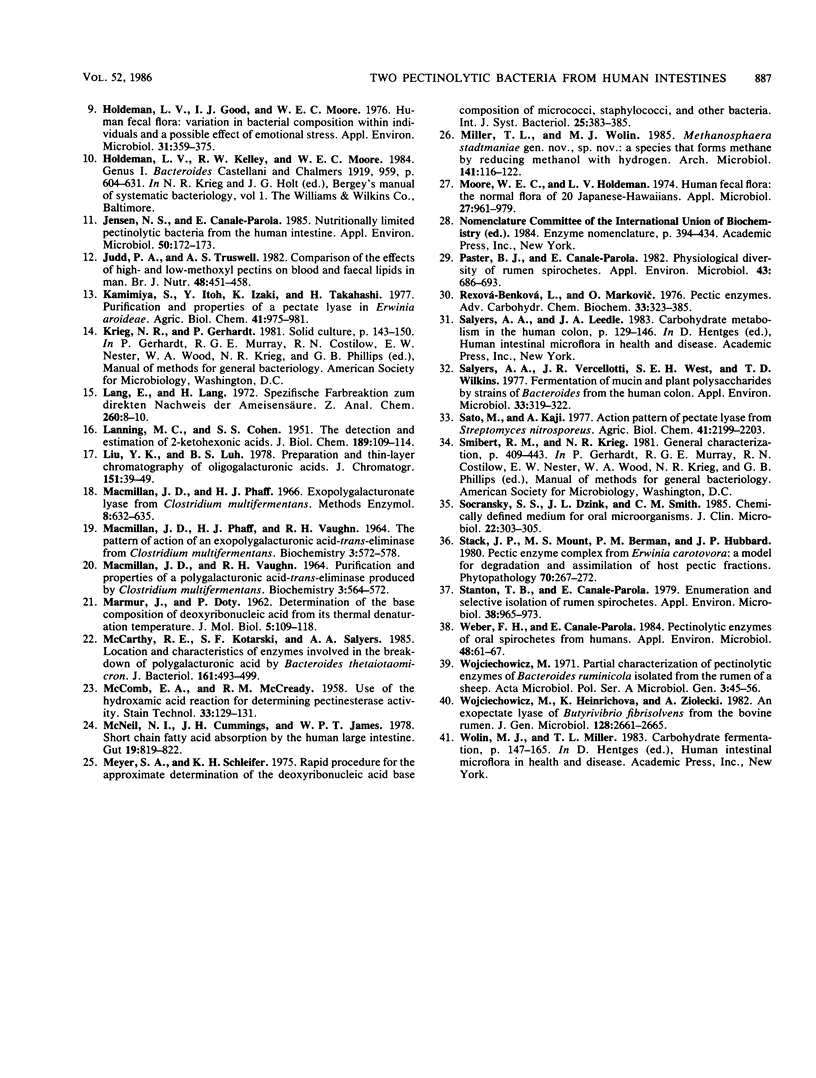
Images in this article
Selected References
These references are in PubMed. This may not be the complete list of references from this article.
- BITTER T., MUIR H. M. A modified uronic acid carbazole reaction. Anal Biochem. 1962 Oct;4:330–334. doi: 10.1016/0003-2697(62)90095-7. [DOI] [PubMed] [Google Scholar]
- BURTON K. A study of the conditions and mechanism of the diphenylamine reaction for the colorimetric estimation of deoxyribonucleic acid. Biochem J. 1956 Feb;62(2):315–323. doi: 10.1042/bj0620315. [DOI] [PMC free article] [PubMed] [Google Scholar]
- Bayliss C. E., Houston A. P. Characterization of plant polysaccharide- and mucin-fermenting anaerobic bacteria from human feces. Appl Environ Microbiol. 1984 Sep;48(3):626–632. doi: 10.1128/aem.48.3.626-632.1984. [DOI] [PMC free article] [PubMed] [Google Scholar]
- Cwyk W. M., Canale-Parola E. Treponema succinifaciens sp. nov., an anaerobic spirochete from the swine intestine. Arch Microbiol. 1979 Sep;122(3):231–239. doi: 10.1007/BF00411285. [DOI] [PubMed] [Google Scholar]
- Harwood C. S., Canale-Parola E. Branched-chain amino acid fermentation by a marine spirochete: strategy for starvation survival. J Bacteriol. 1981 Oct;148(1):109–116. doi: 10.1128/jb.148.1.109-116.1981. [DOI] [PMC free article] [PubMed] [Google Scholar]
- Holdeman L. V., Good I. J., Moore W. E. Human fecal flora: variation in bacterial composition within individuals and a possible effect of emotional stress. Appl Environ Microbiol. 1976 Mar;31(3):359–375. doi: 10.1128/aem.31.3.359-375.1976. [DOI] [PMC free article] [PubMed] [Google Scholar]
- Jensen N. S., Canale-Parola E. Nutritionally limited pectinolytic bacteria from the human intestine. Appl Environ Microbiol. 1985 Jul;50(1):172–173. doi: 10.1128/aem.50.1.172-173.1985. [DOI] [PMC free article] [PubMed] [Google Scholar]
- Judd P. A., Truswell A. S. Comparison of the effects of high- and low-methoxyl pectins on blood and faecal lipids in man. Br J Nutr. 1982 Nov;48(3):451–458. doi: 10.1079/bjn19820130. [DOI] [PubMed] [Google Scholar]
- LANNING M. C., COHEN S. S. The detection and estimation of 2-ketohexonic acids. J Biol Chem. 1951 Mar;189(1):109–114. [PubMed] [Google Scholar]
- MACMILLAN J. D., PHAFF H. J., VAUGHN R. H. THE PATTERN OF ACTION OF AN EXOPOLYGALACTURONIC ACID-TRANS-ELIMINASE FROM CLOSTRIDIUM MULTIFERMENTANS. Biochemistry. 1964 Apr;3:572–578. doi: 10.1021/bi00892a017. [DOI] [PubMed] [Google Scholar]
- MACMILLAN J. D., VAUGHN R. H. PURIFICATION AND PROPERTIES OF A POLYGALACTURONIC ACID-TRANS-ELIMINASE PRODUCED BY CLOSTRIDIUM MULTIFERMENTANS. Biochemistry. 1964 Apr;3:564–572. doi: 10.1021/bi00892a016. [DOI] [PubMed] [Google Scholar]
- MARMUR J., DOTY P. Determination of the base composition of deoxyribonucleic acid from its thermal denaturation temperature. J Mol Biol. 1962 Jul;5:109–118. doi: 10.1016/s0022-2836(62)80066-7. [DOI] [PubMed] [Google Scholar]
- McCOMB E. A., McCREADY R. M. Use of the hydroxamic acid reaction for determining pectinesterase activity. Stain Technol. 1958 May;33(3):129–131. doi: 10.3109/10520295809111836. [DOI] [PubMed] [Google Scholar]
- McCarthy R. E., Kotarski S. F., Salyers A. A. Location and characteristics of enzymes involved in the breakdown of polygalacturonic acid by Bacteroides thetaiotaomicron. J Bacteriol. 1985 Feb;161(2):493–499. doi: 10.1128/jb.161.2.493-499.1985. [DOI] [PMC free article] [PubMed] [Google Scholar]
- McNeil N. I., Cummings J. H., James W. P. Short chain fatty acid absorption by the human large intestine. Gut. 1978 Sep;19(9):819–822. doi: 10.1136/gut.19.9.819. [DOI] [PMC free article] [PubMed] [Google Scholar]
- Miller T. L., Wolin M. J. Methanosphaera stadtmaniae gen. nov., sp. nov.: a species that forms methane by reducing methanol with hydrogen. Arch Microbiol. 1985 Mar;141(2):116–122. doi: 10.1007/BF00423270. [DOI] [PubMed] [Google Scholar]
- Moore W. E., Holdeman L. V. Human fecal flora: the normal flora of 20 Japanese-Hawaiians. Appl Microbiol. 1974 May;27(5):961–979. doi: 10.1128/am.27.5.961-979.1974. [DOI] [PMC free article] [PubMed] [Google Scholar]
- Paster B. J., Canale-Parola E. Physiological diversity of rumen spirochetes. Appl Environ Microbiol. 1982 Mar;43(3):686–693. doi: 10.1128/aem.43.3.686-693.1982. [DOI] [PMC free article] [PubMed] [Google Scholar]
- Rexová-Benková L., Markovic O. Pectic enzymes. Adv Carbohydr Chem Biochem. 1976;33:323–385. doi: 10.1016/s0065-2318(08)60285-1. [DOI] [PubMed] [Google Scholar]
- Salyers A. A., Vercellotti J. R., West S. E., Wilkins T. D. Fermentation of mucin and plant polysaccharides by strains of Bacteroides from the human colon. Appl Environ Microbiol. 1977 Feb;33(2):319–322. doi: 10.1128/aem.33.2.319-322.1977. [DOI] [PMC free article] [PubMed] [Google Scholar]
- Socransky S. S., Dzink J. L., Smith C. M. Chemically defined medium for oral microorganisms. J Clin Microbiol. 1985 Aug;22(2):303–305. doi: 10.1128/jcm.22.2.303-305.1985. [DOI] [PMC free article] [PubMed] [Google Scholar]
- Stanton T. B., Canale-Parola E. Enumeration and selective isolation of rumen spirochetes. Appl Environ Microbiol. 1979 Nov;38(5):965–973. doi: 10.1128/aem.38.5.965-973.1979. [DOI] [PMC free article] [PubMed] [Google Scholar]
- Weber F. H., Canale-Parola E. Pectinolytic enzymes of oral spirochetes from humans. Appl Environ Microbiol. 1984 Jul;48(1):61–67. doi: 10.1128/aem.48.1.61-67.1984. [DOI] [PMC free article] [PubMed] [Google Scholar]
- Wojciechowicz M., Heinrichova K., Ziołecki A. An exopectate lyase of Butyrivibrio fibrisolvens from the bovine rumen. J Gen Microbiol. 1982 Nov;128(11):2661–2665. doi: 10.1099/00221287-128-11-2661. [DOI] [PubMed] [Google Scholar]
- Wojciechowicz M. Partial characterization of pectinolytic enzymes of Bacteroides ruminicola isolated from the rumen of a sheep. Acta Microbiol Pol A. 1971;3(1):45–56. [PubMed] [Google Scholar]



